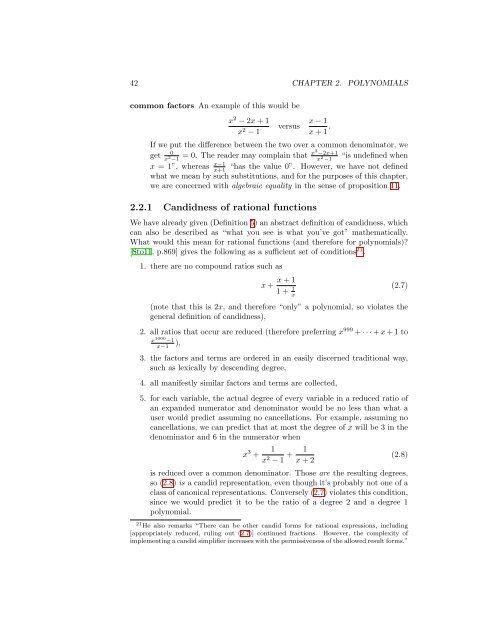Contents - Student subdomain for University of Bath
Contents - Student subdomain for University of Bath
Contents - Student subdomain for University of Bath
You also want an ePaper? Increase the reach of your titles
YUMPU automatically turns print PDFs into web optimized ePapers that Google loves.
42 CHAPTER 2. POLYNOMIALS<br />
common factors An example <strong>of</strong> this would be<br />
x 2 − 2x + 1<br />
x 2 − 1<br />
versus<br />
x − 1<br />
x + 1 .<br />
If we put the difference between the two over a common denominator, we<br />
0<br />
get<br />
x 2 −1 = 0. The reader may complain that x2 −2x+1<br />
x 2 −1<br />
“is undefined when<br />
x = 1”, whereas x−1<br />
x+1<br />
“has the value 0”. However, we have not defined<br />
what we mean by such substitutions, and <strong>for</strong> the purposes <strong>of</strong> this chapter,<br />
we are concerned with algebraic equality in the sense <strong>of</strong> proposition 11.<br />
2.2.1 Candidness <strong>of</strong> rational functions<br />
We have already given (Definition 5) an abstract definition <strong>of</strong> candidness, which<br />
can also be described as “what you see is what you’ve got” mathematically.<br />
What would this mean <strong>for</strong> rational functions (and there<strong>for</strong>e <strong>for</strong> polynomials)?<br />
[Sto11, p.869] gives the following as a sufficient set <strong>of</strong> conditions 21 .<br />
1. there are no compound ratios such as<br />
x + x + 1<br />
1 + 1 x<br />
(2.7)<br />
(note that this is 2x, and there<strong>for</strong>e “only” a polynomial, so violates the<br />
general definition <strong>of</strong> candidness),<br />
2. all ratios that occur are reduced (there<strong>for</strong>e preferring x 999 + · · · + x + 1 to<br />
x 1000 −1<br />
x−1<br />
),<br />
3. the factors and terms are ordered in an easily discerned traditional way,<br />
such as lexically by descending degree,<br />
4. all manifestly similar factors and terms are collected,<br />
5. <strong>for</strong> each variable, the actual degree <strong>of</strong> every variable in a reduced ratio <strong>of</strong><br />
an expanded numerator and denominator would be no less than what a<br />
user would predict assuming no cancellations. For example, assuming no<br />
cancellations, we can predict that at most the degree <strong>of</strong> x will be 3 in the<br />
denominator and 6 in the numerator when<br />
x 3 + 1<br />
x 2 − 1 + 1<br />
x + 2<br />
(2.8)<br />
is reduced over a common denominator. Those are the resulting degrees,<br />
so (2.8) is a candid representation, even though it’s probably not one <strong>of</strong> a<br />
class <strong>of</strong> canonical representations. Conversely (2.7) violates this condition,<br />
since we would predict it to be the ratio <strong>of</strong> a degree 2 and a degree 1<br />
polynomial.<br />
21 He also remarks “There can be other candid <strong>for</strong>ms <strong>for</strong> rational expressions, including<br />
[appropriately reduced, ruling out (2.7)] continued fractions. However, the complexity <strong>of</strong><br />
implementing a candid simplifier increases with the permissiveness <strong>of</strong> the allowed result <strong>for</strong>ms.”












![[Luyben] Process Mod.. - Student subdomain for University of Bath](https://img.yumpu.com/26471077/1/171x260/luyben-process-mod-student-subdomain-for-university-of-bath.jpg?quality=85)



